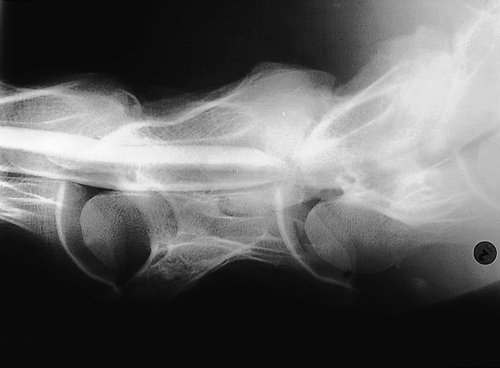Difference between revisions of "Equine Orthopaedics and Rheumatology Q&A 05"
Jump to navigation
Jump to search
Ggaitskell (talk | contribs) |
|||
| (One intermediate revision by one other user not shown) | |||
| Line 16: | Line 16: | ||
|a2=Stenosis of the cervical vertebral canal at the C6/7 level (cervical static malformation). <br><br> | |a2=Stenosis of the cervical vertebral canal at the C6/7 level (cervical static malformation). <br><br> | ||
A focal compressive myelopathy is relatively uncommon in a horse of this age, but, with this history, when it occurs, it usually involves static compression in the caudal cervical spine. | A focal compressive myelopathy is relatively uncommon in a horse of this age, but, with this history, when it occurs, it usually involves static compression in the caudal cervical spine. | ||
| − | |l2=Cervical | + | |l2=Cervical Spinal Stenosis |
|q3=What other conditions might cause similar signs? | |q3=What other conditions might cause similar signs? | ||
|a3= | |a3= | ||
| Line 26: | Line 26: | ||
*Spinal or vertebral neoplasia. | *Spinal or vertebral neoplasia. | ||
|l3=Equine Protozoal Myeloencephalitis | |l3=Equine Protozoal Myeloencephalitis | ||
| + | |||
</FlashCard> | </FlashCard> | ||
Revision as of 16:00, 3 June 2011
| This question was provided by Manson Publishing as part of the OVAL Project. See more Equine Orthopaedic and Rheumatological questions |
A myelogram of the lower cervical spine of a 16-year-old Thoroughbred mare which had shown progressive hindlimb ataxia over 18 months is illustrated.
| Question | Answer | Article | |
| What radiological abnormalities are present? | There is poor definition of the intervertebral facet joints between cervical vertebrae C6 and C7, and almost complete obliteration of dorsal and ventral contrast columns at the same level.
|
Link to Article | |
| What is your diagnosis? | Stenosis of the cervical vertebral canal at the C6/7 level (cervical static malformation). A focal compressive myelopathy is relatively uncommon in a horse of this age, but, with this history, when it occurs, it usually involves static compression in the caudal cervical spine. |
Link to Article | |
| What other conditions might cause similar signs? |
|
[[Equine Protozoal Myeloencephalitis |Link to Article]] | |
